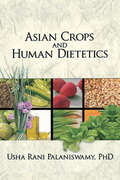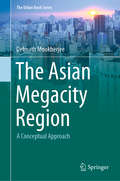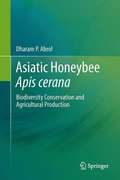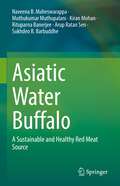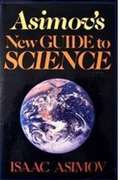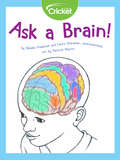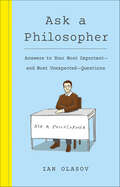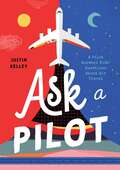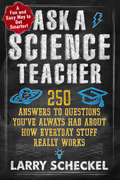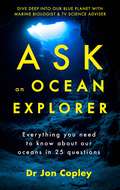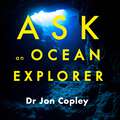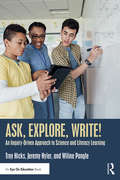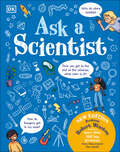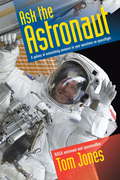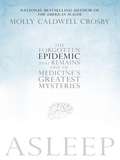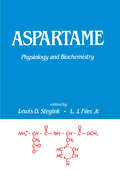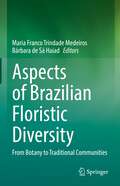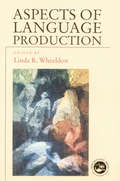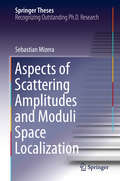- Table View
- List View
Asian Crops and Human Dietetics
by Usha R. PalaniswamyGo beyond the nutritional value to discover the lesser known health benefits of certain Asian crops Several foods from the Asian culture that are not well known to other parts of the world have health benefits that stretch beyond mere nutritional value. Asian Crops and Human Dietetics comprehensively reviews the plants and spices in the A
The Asian Megacity Region: A Conceptual Approach (The Urban Book Series)
by Debnath MookherjeeThis book argues that close and disciplined scrutiny of the Asian megacity regions is of critical importance to understanding Asian urbanization. However, any approach to studying these regions must adopt a multi-dimensional and trans-urban perspective; otherwise, we Without such an approach, we cannot truly make meaningful decisions about growth management and sustainable development for such regions. Amidst the sweeping demographic and structural shifts produced by global urbanization, Asian urbanization has a fascinating and prominent role. Asian urbanization is heterogeneous, and more accurately constitutes “phenomena” than a “phenomenon.” However, despite this diversity, there are certain common features that we can identify. One of them is the Asian “megacity region”— the administrative and/or delineated territory of mixed urban-rural landscape surrounding a giant metropolis.The purpose of this book is to: Understand the main features of 21st century urbanization Note the limitations of current approaches (e.g. disparate scales, city-centric views, inadequate data sets)Articulate a pragmatically framed three-pronged approach (scale-based, trans-urban, multi-dimensional)Demonstrate the application of such an approach with a case study of one of the most important megacity regions in South Asia, the Delhi National Capital Region, underscoring the methodological requirements of such an approach Discuss the next steps for the field as a whole: questions to be raised and directions to be explored for further study. This timely, conceptual and empirical book will appeal to students of urbanization, architects involved in urban policy and planning, and researchers alike.
Asian Space Race: Rhetoric Or Reality?
by Ajey LeleThis book explores the character and contours of the Asian Space Powers. At present, Asian states like China, Japan and India are found investing in space technologies with analogous social and scientific and probably with divergent military intents. Other Asian states like Israel, South Korea and Malaysia are also making investments in the space arena. States like Iran and North Korea are faulted for using space launches as a demonstrative tool to achieve strategic objectives. This work examines this entire maze of activities to unearth where these states are making these investments to accomplish their state-specific goal or are they also trying to surpass each other by engaging in competition. Explaining why and how these states are making investments towards achieving their socio-economic and strategic mandate this book infers that the possibility of Asian Space Race exists but is presently fairly diminutive.
Asiatic Honeybee Apis cerana: Biodiversity Conservation and Agricultural Production
by Dharam P. AbrolDespite its economic usefulness, biodiversity of Asian hive bee Apis cerana is suffering precipitous decline and is threatened with extinction in its entire native habitat. Although a number of publications have appeared on honeybees in the market no attempt has been made to approach the subject in systematically and in a comprehensive manner in case of Apis cerana. There is still not enough knowledge on different facets of biological conservation, agricultural production and role in improving food security and livelihoods. An attempt has been made in this book to fill the gap by providing detailed information on different aspects of Apis cerana leading to sustainability and environmental protection. This book discusses information on varied aspects of Apis cerana biology, biogeography, reproduction, genetics, molecular phylogeny, interaction with other species, floral resources, dance language, safety from pesticides, management problems, loss of genetic diversity, behavioural defence, role in food production, livelihood security and conservation strategies for protecting biodiversity and enhancing crop productivity. The compilation of this book is unique in the sense that in the context of pollinator decline over the world, conservation of this species will be a step for sustaining food security.
Asiatic Water Buffalo: A Sustainable and Healthy Red Meat Source
by Naveena B. Maheswarappa Muthukumar Muthupalani Kiran Mohan Rituparna Banerjee Arup Ratan Sen Sukhdeo B. BarbuddheThis need-based unique book deals exclusively with water buffalo (Bubalus bubalis) meat to provide much needed information to thousands of buffalo meat processors across the world. The information provided in this first-of-its-kind book on buffalo meat quality, nutritional characteristics, safety, and processing can be utilized by buffalo meat producers and meat processors for the advancement of the buffalo meat sector. It also provides valuable information to faculty members, students, researchers, and all other readers interested in this new source of meat. Owing to the limited research and scientific literature available on buffalo meat, the authors’ own research findings and our experiences were included wherever required to give crisp, practical, and complete information. The information proposed in this book should be beneficial to the entire buffalo industry, from the farming and processing of buffaloes to the marketing of products. This serve as a handy guide to meat scientists, faculty members, and students willing to learn more about buffalo meat processing. Up-to-date relevant references were also included for the benefit of researchers and students to enable them to easily access further information. Above all, it provides valuable information to consumers who are interested to know this new and potential source of meat.
Asimov's New Guide to Science
by Isaac AsimovThis is a large book containing sections on physics, the universe, early science, scientists, etc. This book is very large but is written in Asimov's usual, clear style.
Ask a Brain!
by Natalie FrederickThe brain is your body's control center. It collects signals from your senses, thinks and decides, and sends signals that tell your body what to do. Each part of the brain has a special job, and they all work together as you think.
Ask a Philosopher: Answers to Your Most Important—and Most Unexpected—Questions
by Ian OlasovA collection of answers to the philosophical questions on people's minds—from the big to the personal to the ones you didn't know you needed answered.Based on real-life questions from his Ask a Philosopher series, Ian Olasov offers his answers to questions such as:- Are people innately good or bad?- Is it okay to have a pet fish?- Is it okay to have kids?- Is color subjective?- If humans colonize Mars, who will own the land?- Is ketchup a smoothie?- Is there life after death?- Should I give money to homeless people?Ask a Philosopher shows that there's a way of making philosophy work for each of us, and that philosophy can be both perfectly continuous with everyday life, and also utterly transporting. From questions that we all wrestle with in private to questions that you never thought to ask, Ask a Philosopher will get you thinking.
Ask a Pilot
by Justin KelleyAuthor, pilot, and dad Justin Kelley puts kids at ease by answering twenty of their most pressing questions. Flying is fascinating, and kids have questions! Why don't planes hit each other in the sky? Do you start a plane with a key? Why do my ears feel funny? With friendly language, simple explanations, and colorful illustrations, Ask a Pilot is the perfect handbook for aviation lovers and nervous flyers alike! From the Introduction: Do you dream of flying? If you answered yes, then this book is for you. On the other hand, if you answered no, and you started to sweat a little, and your heart started racing because the thought of trusting a huge, metal airplane that stays in the air by some unknown magic terrifies you, well . . . this book is also for you. Especially for you. In this book, you’ll find answers to real questions from real kids. Some are funny, some are serious, but all of them have real answers to help make flying a little less mysterious.
Ask a Science Teacher: 250 Answers to Questions You've Always Had About How Everyday Stuff Really Works
by Larry ScheckelFun and fascinating science is everywhere, and it’s a cinch to learn—just ask a science teacher! We’ve all grown so used to living in a world filled with wonders that we sometimes forget to wonder about them: What creates the wind? Do fish sleep? Why do we blink? These are common phenomena, but it’s a rare person who really knows the answers—do you? All too often, the explanations remain shrouded in mystery—or behind a haze of technical language. For those of us who should have raised our hands in science class but didn’t, Larry Scheckel comes to the rescue. An award-winning science teacher and longtime columnist for his local newspaper, Scheckel is a master explainer with a trove of knowledge. Just ask the students and devoted readers who have spent years trying to stump him! In Ask a Science Teacher, Scheckel collects 250 of his favorite Q&As. Like the best teachers, he writes so that kids can understand, but he doesn’t water things down— he’ll satisfy even the most inquisitive minds. Topics include:•The Human Body •Earth Science •Astronomy •Chemistry Physics •Technology •Zoology •Music and conundrums that don’t fit into any category With refreshingly uncomplicated explanations, Ask a Science Teacher is sure to resolve the everyday mysteries you’ve always wondered about. You’ll learn how planes really fly, why the Earth is round, how microwaves heat food, and much more—before you know it, all your friends will be asking you!
Ask an Ocean Explorer
by Dr Jonathan Copley'Like Sir David Attenborough, he has the rare ability to be an excellent communicator and has written an engaging book sprinkled with mind-blowing facts about the deep oceans' - Daily Express'A new informed perspective on the wide, watery world we inhabit' - Coast magazine 'Book of the month''The gripping story of how ocean science has advanced in recent years is captivatingly told by Jon Copley in this introduction to the deep ocean' - China Dialogue'Deftly conjures the wonders of a bathynaut's world' - NatureIt is often said that we know more about space than we do our own oceans, but is that really the case? Or do we in fact know a great deal more about the oceans than many people realise.The wellbeing of our oceans and the life contained within and around them has never been more important. But to truly understand the vital role they play, we need to first understand how the oceans work, how we explore them and learn about the mysteries they hold, and what our effect is on them.Between these pages is everything you need to know about our oceans, explained in 25 questions. Combining untold history of ocean exploration and personal account of what it's like to be a 'bathynaut' diving in a mini-submarine, Ask an Ocean Explorer brings to light weird and wonderful deep-sea creatures and how the oceans and their future is connected to our everyday lives.
Ask an Ocean Explorer
by Dr Jonathan CopleyHow deep do sharks swim? Have more people been into space then the deep ocean? And what effect are we having on the health of our seas? Ask An Ocean Explorer answers these questions and more!'Our everyday lives are connected to the deep ocean in ways we seldom realise.'In this audiobook is everything you need to know about our oceans, explained in 25 questions. In Ask An Ocean Explorer marine biologist of over 20 years and advisor for the BBC's Blue Planet II, Dr Jon Copley, explains the science and wonder of the deep ocean. Combining untold history of ocean exploration and personal account of what it's like to be a 'bathynaut' diving in a mini-submarine, Ask An Ocean Explorer will bring to light weird and wonderful deep-sea creatures that we find down there and how the oceans and their health is connected to our everyday lives.(P)2019 Hodder & Stoughton Limited
Ask an Ocean Explorer
by Jonathan Copley'Like Sir David Attenborough, he has the rare ability to be an excellent communicator and has written an engaging book sprinkled with mind-blowing facts about the deep oceans' - Daily Express <P><P>'A new informed perspective on the wide, watery world we inhabit' - Coast magazine 'Book of the month' <P><P>'The gripping story of how ocean science has advanced in recent years is captivatingly told by Jon Copley in this introduction to the deep ocean' - China Dialogue <P><P>'Deftly conjures the wonders of a bathynaut's world' - Nature <P><P>It is often said that we know more about space than we do our own oceans, but is that really the case? Or do we in fact know a great deal more about the oceans than many people realise. <P><P>The wellbeing of our oceans and the life contained within and around them has never been more important. But to truly understand the vital role they play, we need to first understand how the oceans work, how we explore them and learn about the mysteries they hold, and what our effect is on them. <P><P>Between these pages is everything you need to know about our oceans, explained in 25 questions. Combining untold history of ocean exploration and personal account of what it's like to be a 'bathynaut' diving in a mini-submarine, Ask an Ocean Explorer brings to light weird and wonderful deep-sea creatures and how the oceans and their future is connected to our everyday lives.
Ask The Beasts: Darwin and the God of Love
by Elizabeth A. JohnsonFor millennia plant and animal species have received little sustained attention as subjects of Christian theology and ethics in their own right. Focused on the human dilemma of sin and redemptive grace, theology has considered the doctrine of creation to be mainly an overture to the main drama of human being`s relationship to God. What value does the natural world have within the framework of religious belief? The crisis of biodiversity in our day, when species are going extinct at more than 1,000 times the natural rate, renders this question acutely important. Standard perspectives need to be realigned; theology needs to look out of the window, so to speak as well as in the mirror. Ask the Beasts: Darwin and the God of Love leads to the conclusion that love of the natural world is an intrinsic element of faith in God and that far from being an add-on, ecological care is at the center of moral life.
Ask, Explore, Write!: An Inquiry-Driven Approach to Science and Literacy Learning
by Troy Hicks Jeremy Hyler Wiline PangleDiscover how to effectively incorporate literacy instruction into your middle or high school science classroom with this practical book. You’ll find creative, inquiry-based tools to show you what it means to teach science with and through writing, and strategies to help your students become young scientists who can use reading and writing to better understand their world. Troy Hicks, Jeremy Hyler, and Wiline Pangle share helpful examples of lessons and samples of students’ work, as well as innovative strategies you can use to improve students’ abilities to read and write various types of scientific nonfiction, including argument essays, informational pieces, infographics, and more. As all three authors come to the work of science and literacy from different perspectives and backgrounds, the book offers unique and wide-ranging experiences that will inspire you and offer you insights into many aspects of the classroom, including when, why, and how reading and writing can work in the science lesson. Featured topics include: Debates and the current conversation around science writing in the classroom and society. How to integrate science notebooks into teaching. Improving nonfiction writing by expanding disciplinary vocabulary and crafting scientific arguments. Incorporating visual explanations and infographics. Encouraging collaboration through whiteboard modeling. Professional development in science and writing. The strategies are all aligned to the Next Generation Science Standards and Common Core State Standards for ease of implementation. From science teachers to curriculum directors and instructional supervisors, this book is essential for anyone wanting to improve interdisciplinary literacy in their school.
Ask A Scientist (New Edition): Professor Robert Winston Answers More Than 100 Big Questions From Kids Around the World!
by Robert WinstonRobert Winston answers 100 big questions from kids across the world in this fun and unique science book.In this unique science book, Professor Robert Winston answers more than 100 real-life questions from children all around the world! And who could be a better scientist to ask questions to than Professor Robert Winston? Ask a Scientist puts the fun back into science in this thrilling book for children aged 6-9. All the popular science topics are covered, with weird and wacky questions and clear and lively answers, including biology: &“Why do freckles come in dots on your face?&”; physics: &“Could you jump off the world?&”; Earth: &“Why is the sky blue?&”; chemistry: &“Why are there bubbles in boiling water?&”; natural science: &“Do dogs cry?&”, and space: &“Why will the Sun explode and make us extinct?&”. This exciting new edition includes eight pages of additional questions relating to the recent hot topics in science, including the COVID-19 pandemic. Inside the pages of this quirky science book, you&’ll find: - Every aspect of science: including biology; space; physics; chemistry; Earth; natural sciences.- The topic of science presented in a fresh, exciting way, by tackling it from the child&’s perspective.- More than 100 real-life questions from children from all around the world about every aspect of science.- Updated reissue of the 2019 edition with an additional eight new pages, including coverage of important recent topics such as the COVID-19 pandemic.The inspiration behind this unique science book came from the many questions posed by Robert Winston&’s grandchildren and by children from the schools he has visited over the years. The book includes some of these questions, plus many more gathered from countries all over the world – including the UK, Ireland and mainland Europe, Canada, the USA, India, China, and Japan. The 100 big questions featured inside the book cover all the main science topics: chemistry, physics, biology, Earth, space, and natural science.
Ask the Astronaut: A Galaxy of Astonishing Answers to Your Questions on Spaceflight
by Tom JonesEver wondered what space is really like? Thanks to his 25 years of training for, flying in, consulting on, and writing and speaking about space, astronaut and spacewalker Tom Jones can answer that question and many others. What do you feel on liftoff? What is weightlessness? Where do you sleep in space? Can you see the Great Wall of China? Jones answers every question you have ever had about space in Ask the Astronaut. His entertaining blend of wit, personal experience, and technical expertise shines in each answer, and together all the answers illuminate the true space experience from start to finish. His engaging and informative responses remind readers of historic space achievements, acquaint them with exciting new ambitions, make them feel like they have experienced space firsthand, and even inspire an urge to explore space themselves. Jones covers everything from the training process for new astronaut candidates and the physical sensations and challenges of rocketing into orbit to what it's like to live, work, and walk in space. Jones also explores the future of spaceflight, both professional and commercial, in the years to come. Ask the Astronaut is a delight for all readers, especially "armchair astronauts" and younger, 21st century space explorers.
Asking about Life (3rd edition)
by Allan J. Tobin Jennie DusheckThis undergraduate-level introductory biology textbook presents its chapter and heading sections in the form of questions and begins each chapter with a story about how a biologist or group of biologists asked questions about life in order to investigate biology. Forty-five chapters cover chemistry and cell biology, genetics, evolution, biological diversity, ecology, and structural and physiological adaptations of flowering plants and of animals. Annotation ©2004 Book News, Inc., Portland, OR (booknews.com)
Asleep
by Molly Caldwell CrosbyA fascinating look at a bizarre, forgotten epidemic from the national bestselling author of The American Plague. In 1918, a world war raged, and a lethal strain of influenza circled the globe. In the midst of all this death, a bizarre disease appeared in Europe. Eventually known as encephalitis lethargica, or sleeping sickness, it spread worldwide, leaving millions dead or locked in institutions. Then, in 1927, it disappeared as suddenly as it arrived. Asleep, set in 1920s and '30s New York, follows a group of neurologists through hospitals and asylums as they try to solve this epidemic and treat its victims-who learned the worst fate was not dying of it, but surviving it.
Asleep
by Molly Caldwell CrosbyA fascinating look at a bizarre, forgotten epidemic from the national bestselling author of The American Plague. In 1918, a world war raged, and a lethal strain of influenza circled the globe. In the midst of all this death, a bizarre disease appeared in Europe. Eventually known as encephalitis lethargica, or sleeping sickness, it spread worldwide, leaving millions dead or locked in institutions. Then, in 1927, it disappeared as suddenly as it arrived. Asleep, set in 1920s and '30s New York, follows a group of neurologists through hospitals and asylums as they try to solve this epidemic and treat its victims-who learned the worst fate was not dying of it, but surviving it.
Aspartame: Physiology and Biochemistry
by Filer SteginkThis book summarizes the research that resulted in aspartame's approval as a food additive as well as related topics regarding its function as a potential sweetening agent. It complies specific issues relating to human consumption of aspartame.
Aspects of Brazilian Floristic Diversity: From Botany to Traditional Communities
by Maria Franco Trindade Medeiros Bárbara de Sá HaiadAspects of Brazilian Floristic Diversity: From Botany to Traditional Communities offers a unique approach in floristic diversity of the Neotropical region, specifically encompassing the Brazilian flora. This volume combines both theoretical and applied aspects of scientific making knowledge in different perspectives of Botanical Science. In this volume, botanical specialists discuss the many different approaches of taxonomic, reproductive, ecological and ethnobotanical aspects of Brazilian floristic diversity, thereby enlightening the global interest in Neotropical species, in particular those from the Brazilian territory. The book addresses relevant questions from many points of view, including anatomy, reproduction, palinology, conservation and ethnobotany, creating an in-depth perception of the flora in its complexity constitution.The book provides a comprehensive outlook on Botany Sciences, considering the history and traditional knowledge of plants, and relating it to contemporary problems and concerns of flora conservation today. With this current perspective, this book reaches a vast audience from the research lines of Botany, and encompasses a broader and interdisciplinary understanding of Aspects of Brazilian Floristic Diversity.
Aspects of Language Production (Studies in Cognition)
by Linda WheeldonThis volume represents major research issues in language production today, presenting readers with a picture of the breadth of current research in the field. Contributors have focused on models of visual word processing, aphasic speech, object recognition and language production in children. Many chapters highlight the need for psychological models of language production to learn from theoretical linguistics in order to become better informed about the structure of language itself. Therefore, this volume also includes chapters written by linguists for psychologists which serve to remind us of the complexity of structure and process in the languages of the world.
Aspects of Scattering Amplitudes and Moduli Space Localization (Springer Theses)
by Sebastian MizeraThis thesis proposes a new perspective on scattering amplitudes in quantum field theories. Their standard formulation in terms of sums over Feynman diagrams is replaced by a computation of geometric invariants, called intersection numbers, on moduli spaces of Riemann surfaces. It therefore gives a physical interpretation of intersection numbers, which have been extensively studied in the mathematics literature in the context of generalized hypergeometric functions. This book explores physical consequences of this formulation, such as recursion relations, connections to geometry and string theory, as well as a phenomenon called moduli space localization. After reviewing necessary mathematical background, including topology of moduli spaces of Riemann spheres with punctures and its fundamental group, the definition and properties of intersection numbers are presented. A comprehensive list of applications and relations to other objects is given, including those to scattering amplitudes in open- and closed-string theories. The highlights of the thesis are the results regarding localization properties of intersection numbers in two opposite limits: in the low- and the high-energy expansion. In order to facilitate efficient computations of intersection numbers the author introduces recursion relations that exploit fibration properties of the moduli space. These are formulated in terms of so-called braid matrices that encode the information of how points braid around each other on the corresponding Riemann surface. Numerous application of this approach are presented for computation of scattering amplitudes in various gauge and gravity theories. This book comes with an extensive appendix that gives a pedagogical introduction to the topic of homologies with coefficients in a local system.
